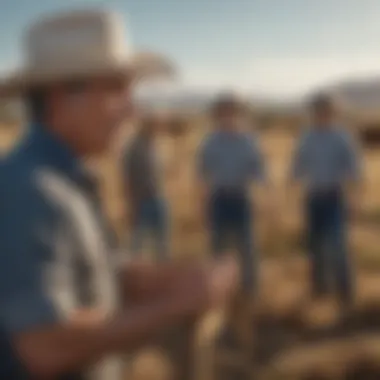Exploring Ranch Assistance for Sustainable Growth


Intro
Ranching is an age-old tradition that plays a crucial role in global agriculture and food production. Across various landscapes, ranches are now facing challenges that require them to seek external assistance. Understanding these challenges and the ensuing collaborations can provide insight into how ranches can thrive in an ever-changing environment. This article will explore the pressing need for support in ranching operations, highlighting the factors of assistance, key techniques, solutions to common obstacles, and the diverse roles technology and community play.
Overview of the Topic
Definition and Importance
Ranching involves the practice of raising animals for meat, milk, and other byproducts. This sector is vital to many economies and sustains local communities. However, with changes in climate, market demands, and technology, ranches are increasingly seeking help to adapt. Support can come in various forms, including financial aid, educational resources, and technological advances.
Current Trends
Currently, there is a marked trend towards sustainability in ranching practices. Ranchers are more focused on environmentally friendly methods and efficient resource management. This shift often requires knowledge and skills that existing ranch operators may not have. Therefore, partnerships with experts and community members become essential to ensure sustainable practices.
Key Techniques and Practices
Step-by-Step Guide
To effectively seek assistance, ranches can follow a structured approach:
- Assess Needs: Identify the specific areas where help is required, such as animal health, pasture management, or marketing strategies.
- Research Resources: Explore local universities, agricultural extensions, and non-profit organizations that offer support programs.
- Engage the Community: Connect with local farmers and agricultural groups to share experiences and gather advice.
- Leverage Technology: Utilize agricultural technology tools for better management and data analysis.
Tools and Equipment Needed
Investing in the right tools is crucial. Some essential equipment might include:
- Soil testing kits to assess land quality.
- Animal health monitoring devices.
- Software for financial management and operations planning.
Challenges and Solutions
Common Obstacles
Ranchers often face several challenges. The most frequent are:
- Financial Constraints: Limited budgets affect the ability to procure necessary assistance.
- Knowledge Gaps: Lack of training in modern agricultural practices and technology.
- Market Volatility: Fluctuating prices for livestock and produce can create uncertainty.
Innovative Solutions
Addressing these challenges requires thoughtful solutions. Some innovative approaches include:
- Community Supported Agriculture (CSA): Partnerships that enable local consumers to support ranches financially.
- AgTech Innovations: Use of precision agriculture tech to optimize resources and data collection.
- Training Programs: Engagement with universities for workshops on sustainable practices.
Quote: "Strengthening the ties between ranchers and community organizations can enhance resilience in agricultural practices."
Prelude
In the realm of modern agriculture, ranching stands as a vital component, contributing significantly to food production, job creation, and rural economies. However, the landscape of ranching is shifting, revealing pressing needs that call for assistance and support. This article delves into these needs, exploring why ranches are seeking help and the various opportunities that arise from this quest.
One cannot underestimate the importance of addressing the challenges ranches face today. Numerous factors are at play, including labor shortages, economic pressures, and the need for advanced technological skills. Understanding these underlying issues is key to grasping the full scope of this topic. Moreover, exploring how ranches can benefit from community support, partnerships with educational institutions, and leveraging technology for their operations presents an opportunity not only for ranchers but also for individuals looking to engage with the agriculture sector.
By examining the factors that lead to a ranch's need for assistance, this article seeks to reveal the specific skills and resources that can enhance productivity. We aim to create a narrative that showcases the potential for collaboration, whether through volunteer programs, internships, or advances in technology.
This exploration is more than a mere analysis; it is a call to action for enthusiasts, professionals, and community members. Understanding these dynamics can facilitate connections that enhance both ranching practices and individual engagement in agricultural efforts. As we journey through the intricacies of ranching assistance, we prepare to unveil the initiatives that can foster sustainable practices and improve the economic viability of ranch operations.
Understanding the Context
This section sets the stage for our discussion on ranches seeking assistance. Context is crucial in understanding the challenges faced by ranchers today. The modern ranching environment is marked by evolving agricultural practices, economic fluctuations, and societal changes. To appreciate these factors, it is essential to explore their historical and social significance.
Ranching has long been intertwined with the American way of life, embodying values of independence and self-sufficiency. Yet, current trends reveal a divergence from these ideals, fueled by growing consumer demands for sustainable practices, animal welfare, and local sourcing of food products. Ranches are confronted with the pressure to adapt rapidly to meet these expectations.


Additionally, changes in demographics influence the workforce available for ranching. Many young individuals are moving towards urban areas, leaving a gap in labor that ranches increasingly struggle to fill. This loss of manpower compels ranchers to seek assistance in multiple areas, including staffing, training, and technological integration.
In summary, understanding the context means recognizing the complexities ranches face. It highlights the intersection of tradition and modernity, where ranchers must navigate a challenging path to maintain their legacy while embracing new methodologies and support systems. As we progress through the article, this context will be essential to grasp the significance of the discussions on collaboration and resource sharing.
The State of Modern Ranching
The field of modern ranching is intricately tied to not only agricultural practices but also to the economic and social fabric of rural areas. As ranches face evolving challenges over the years, understanding the state of modern ranch management has become essential. Modern ranching signifies a shift towards more sustainable and innovative practices that address both traditional needs and contemporary pressures. The interplay between technology, management strategies, and environmental concerns enhances productivity and long-term viability in ranch operations.
Current Challenges in Ranch Management
Ranch management today grapples with several pressing challenges. One significant issue is the labor shortage. Many ranches are struggling to find skilled workers, making it difficult to maintain day-to-day operations. As a result, ranchers often bear a heavier workload, leading to burnout and reduced efficiency.
Additionally, ranchers face unpredictable weather conditions impacted by climate change. This volatility can result in significant losses, from droughts affecting feed supply to floods damaging infrastructure.
Financial constraints add to these woes. The cost of inputs such as feed, fuel, and equipment continues to rise, squeezing profit margins. With fluctuating market prices for livestock products, many ranchers find it hard to secure stable income, necessitating assistance in managing finances and investments.
Economic Pressures and Opportunities
Despite these challenges, economic pressures can also create opportunities for ranches. For instance, there has been a growing demand for organic and locally produced food. This shift in consumer preferences paves the way for ranches to expand into niche markets. By adopting sustainable practices, ranchers can cater to health-conscious consumers willing to pay a premium.
Furthermore, the use of technological advancements presents a unique opportunity. Precision agriculture tools, such as drones and monitoring systems, facilitate better resource management. Implementation of these technologies can significantly improve yield and reduce waste.
"The essence of modern ranching lies in adaptability and embracing new practices for long-term success."
This dynamic landscape underscores the need for collaboration and support across various sectors. By understanding the current challenges and opportunities, ranchers can position themselves strategically within the industry.
Factors Leading to the Need for Help
The ranching industry today faces numerous challenges. Many ranches are feeling the strain of various pressures that lead them to seek assistance. Understanding these factors is essential for addressing the needs of ranches and enhancing their sustainability and productivity.
Labor Shortages
Labor shortages have become a significant concern for ranches of all sizes. This issue is not merely an inconvenience; it disrupts the daily operations that keep ranches functioning effectively. Many ranchers are finding it tough to hire enough workers to meet their needs. Various reasons contribute to this problem, including a declining interest in agricultural professions among younger generations and the physical demands of the work itself. As a result, ranchers often resort to hiring seasonal workers, which does not provide the stability they require in their operations.
"The shortage of qualified labor impacts the ability of ranches to produce food efficiently and sustainably."
Moreover, when ranches lack a dependable workforce, productivity can suffer. This leads to stress on the existing workers, who are often overburdened with additional duties. Such a situation can create a vicious cycle, making it even harder to attract new labor.
Skill Gaps in the Workforce
Even when labor is available, many workers may lack the necessary skills required for modern ranching operations. The ranching landscape has evolved, incorporating advanced techniques and technologies. As such, the demand for skilled labor has increased. Unfortunately, there are gaps in skills among potential workers.
Many individuals entering the workforce may have limited agricultural knowledge or experience with new farming technologies. This disparity results in ranchers spending significant resources in training new hires rather than focusing on operational efficiency. The need for skill development programs becomes critical. By addressing these skill gaps, ranches can improve productivity and integrate innovative practices that enhance their sustainability efforts.
Technological Adaptation Requirements
With the rise of technology in the agricultural sector, ranches are now required to adapt to new tools and systems to stay competitive. However, not all ranchers are equipped to embrace this shift. Technological advancements, such as drone surveillance, precision agriculture, and advanced livestock management systems, present a steep learning curve.
Ranches seeking assistance must also navigate this changing landscape. Training for both existing and new employees on technological applications can be costly and time-consuming. Ranchers often need support from educational institutions or technology partners to bridge this gap, ensuring they can implement these tools effectively. The future of ranching heavily depends on its ability to adapt to these technological demands.
With these factors combined, it is clear that ranches are at a critical point. The need for help arises from core operational pressures requiring a collaborative approach to ensure their success.
Skills and Resources Sought by Ranches
Ranches today face a multifaceted landscape of challenges that necessitate a reassessment of the skills and resources they require for effective operation. Understanding these needs is crucial not only for ranches but also for those looking to assist or engage in collaborative efforts. Skills and resources can significantly enhance productivity, sustainability, and overall viability.
Key Skills Needed in Ranch Operations
The modern ranching environment requires a diverse set of skills that revolve around both traditional practices and modern agricultural technology. Some of the key skills sought by ranchers include:
- Animal Husbandry: Knowledge of breeding, feeding, and care of livestock is fundamental. This includes understanding animal health, nutrition, and welfare.
- Land Management: Skills related to soil health, crop rotation, and pasture management are essential for maintaining the ecosystem and ensuring long-term viability.
- Technical Proficiency: Familiarity with software tools and technological equipment is becoming increasingly important. Ranches may seek individuals skilled in data management systems that track animal performance, feed quality, and crop yields.
- Marketing and Sales: An understanding of market trends and direct-to-consumer strategies can help ranches maximize profits and efficiently distribute their products.
- Operational Management: This includes skills in budgeting, planning, and logistics to ensure efficient operation of ranch activity.


The incorporation of these skills can lead not only to improved ranch management but also to a more dynamic and engaging work environment. As the agricultural sector becomes more competitive, ranches need personnel who can adapt and innovate.
Resources for Enhanced Productivity
In addition to skills, resources are also critical for ranchers seeking assistance. These resources contribute to more efficient operations and can ultimately lead to increased productivity. Key resources sought after include:
- Financial Support: Grants, loans, and other forms of funding can provide necessary capital for investing in technology, feed, and infrastructure. Programs from various agricultural departments can be explored to find potential funding sources.
- Educational Resources: Workshops, seminars, and mentorship programs offered by agricultural institutions or community colleges can provide ranchers with updated practices and new methodologies.
- Technological Tools: The introduction of drones for monitoring crop and livestock health, or precision farming tools that enhance resource use, can play a vital role in improving efficacy on ranches.
- Networking Opportunities: Platforms that connect ranchers, agronomists, and local businesses allow for knowledge sharing and collaboration.
Collaborative efforts lead to enhanced problem-solving strategies and innovative practices that benefit the agricultural community as a whole.
Access to the right skills and resources can drastically improve a ranch’s operational capacity. Addressing these needs effectively is fundamental for ranches aiming to navigate the complexities of modern agricultural demands.
Collaborative Approaches to Address Needs
In the face of numerous challenges, collaborative approaches emerge as a vital pathway for ranches seeking assistance. Such collaborations can enhance operations not just through manpower but by enriching knowledge and resources. Through the collective efforts of communities, educational institutions, and technology partners, ranches can address pressing issues more effectively. Key benefits are evident, including improved productivity, diversified support systems, and sustainable practices that can enhance the overall resilience of the ranching industry.
Community Engagement and Support Systems
Community engagement presents a dual opportunity for ranches: it fosters local support while enabling ranchers to connect with potential helpers. When ranches actively involve community members, they create a network of resources that can include anything from volunteer labor to local knowledge sharing. For instance, local outreach programs can introduce urban residents to rural life. They can volunteer their time, gaining valuable experience and insights into ranching operations.
This collaboration can lead to increased awareness of the challenges ranches face. Moreover, the community stands to benefit as well, by supporting local agriculture and contributing to food security. Initiatives such as community farming events or open days at ranches help build relationships between ranchers and local volunteers. These relationships cultivate goodwill; they become crucial during busy seasons when ranchers need extra hands.
Partnerships with Educational Institutions
Forming partnerships with educational institutions is another effective strategy for addressing ranch needs. Universities and vocational schools often seek real-world experiences for their students. By collaborating with these institutions, ranches can tap into a pool of eager learners who are ready to contribute while gaining hands-on experience in the field.
These partnerships can lead to innovative programs, such as internships or research projects focused on sustainable practices or livestock management techniques. Faculty members may provide expertise on specific challenges, ensuring that ranch managers get access to the latest innovations in agriculture. Over time, this mutual relationship can promote long-term change by equipping future generations with practical skills and a deeper understanding of ranch management.
Technological Collaborations
Embracing technology is essential for modern ranches. Collaborations that focus on technological advancements can provide ranches with tools that make operations more efficient. The use of technology can help ranchers access solutions for everything from animal health to crop management. For instance, drone technology can assist in monitoring crop health, while software platforms develop management efficiencies.
Ranches should seek partnerships with tech companies that specialize in agricultural innovations. These partnerships can lead to pilot programs that test new technologies and gauge their effectiveness in real-world situations. Technology also provides opportunities for ranches to connect with help through online platforms. By marketing their needs through digital channels, ranches can attract talent, volunteers, and resources that may not have been accessible otherwise.
Investing in technological collaborations is an investment in the future of ranching. By leveraging technology and innovation, ranches can improve their sustainability and economic viability.
In summary, collaborative approaches can offer ranches numerous avenues to seek help effectively. By engaging with the community, forming educational partnerships, and embracing technology, ranch operations can address their needs while promoting sustainable growth.
Tapping into Volunteer and Internship Programs
Ranches are increasingly looking towards volunteer and internship programs as viable avenues to secure assistance. These programs play a significant role in connecting individuals eager to learn about ranching with established operations seeking reliable help. As such, they create a symbiotic relationship that benefits both ranches and participants, fostering growth in the agricultural sector.
Opportunities for Enthusiasts
For those passionate about agriculture, the chance to volunteer or intern at a ranch can be an invaluable experience. Participants often engage in a variety of tasks such as animal husbandry, crop cultivation, and maintenance of facilities. This hands-on involvement allows them to gain practical skills that formal education may not provide.
Furthermore, these programs typically welcome people from diverse backgrounds. Whether someone is a student majoring in agricultural sciences or simply an individual interested in agriculture, ranches value their diverse input. This creates enriching learning environments. Some volunteers may also get opportunities to learn about sustainable practices, which are becoming increasingly relevant.
Benefits for Ranches and Volunteers
The advantages of these programs are quite clear for both parties involved.
- For Ranches:
Adding volunteers provides immediate assistance without the long-term commitment of hiring full-time staff. They find the extra hands crucial during busy seasons, such as calving or harvest times. Volunteers may also introduce new ideas or techniques learned from other farms or backgrounds, thus enhancing productivity. Moreover, ranches can often save costs while still maintaining high operational standards through these programs. - For Volunteers:
Participants benefit from the rich, experiential learning associated with ranching. They can develop a wide range of skills in a real-world setting while building meaningful relationships with mentors and other enthusiasts. Many volunteers aim to explore potential career paths in agriculture. Such exposure can lead to job offers in the future, with ranches often considering exceptional volunteers for paid positions.
Overall, tapping into volunteer and internship programs creates a pathway that enriches not just the ranch operations, but also the lives of individuals eager to immerse themselves in the world of agriculture. As we explore this avenue further, it is essential to recognize the potential growth these collaborations can lead to—keeping the ranching sector vibrant and sustainable.
"Volunteering at ranches provides a practical foundation for anyone eager to enter the agricultural industry."
Both ranches and volunteers stand to gain significantly from these mutual collaborations. Thus, these programs serve as a critical element in the broader strategy for addressing the challenges faced by modern ranching.


The Role of Technology in Connecting Ranches with Help
Technology plays an increasingly pivotal role in modern ranching. Its application can significantly enhance connectivity between ranchers and the assistance they seek. This section examines how technology fosters relationships, facilitates resource sharing, and helps address the myriad challenges faced by ranches today.
Benefits of Technology in Ranching Assistance
- Enhanced Communication: Technology reduces barriers. Ranchers can reach potential helpers quickly and efficiently. This immediacy allows for real-time problem-solving and collaboration.
- Resource Management: Tools like software applications assist with the organization of resources. Ranchers can track their needs and manage logistics effectively.
- Wider Reach: Through online platforms, ranches can connect with a broader pool of volunteers and interns. The geographic constraints are reduced, leading to diversified support.
Online Platforms for Job Listings
Online platforms are a vital resource for ranches to find and post job listings. Websites such as Craigslist and Indeed provide a space where ranches can advertise their need for support. These platforms allow for targeted outreach to individuals interested in agricultural work.
Utilizing job boards enables ranchers to specify their requirements, including skills and duration of work needed. This specificity helps attract suitable candidates who are genuinely interested in ranching.
Moreover, these platforms often allow for targeted advertising. Ranches can promote their listings to specific demographics. This means ranchers can tap into local talent or individuals who are already interested in farming activities.
Utilizing Social Media for Outreach
Social media is a powerful tool for ranches looking for assistance. Platforms like Facebook and Instagram allow ranchers to showcase their operations and connect with the community directly. By sharing updates about their ranch and specific needs, ranchers can foster a sense of community and engagement.
Effective usage of hashtags can increase visibility. By using tags related to agriculture or volunteering, ranchers can reach individuals who are passionate about these topics.
Additionally, social media creates a space for discussions and networking. Ranchers can share their experiences and learn from others. This; in turn, can motivate volunteers and internships to engage with ranching initiatives.
Social media also provides a way for ranchers to express gratitude to volunteers and contributors. Highlighting these efforts increases community goodwill and attracts more assistance in the future.
"Technology is not only a tool; it is vital for connecting ranchers with those who care to help."
In summary, technology serves as a backbone in connecting ranchers with the help they need, whether through online job listings, or social media outreach. Embracing these tools can lead to better engagement and ultimately more sustainable ranching practices.
Sustainability: Motivating Factor for Seeking Help
Sustainability plays a critical role in the operations of modern ranches. In this context, seeking assistance becomes not just a matter of productivity but also of aligning with environmental stewardship and long-term viability. By integrating sustainable practices, ranchers can address current challenges while ensuring that future generations can continue their legacy in ranching. The connection between sustainability and seeking help is reflected in ranchers' growing interest in resources that foster responsible management of their lands, livestock, and community relationships.
Environmental Practices in Ranching
Environmental practices in ranching primarily focus on preserving natural resources and promoting biodiversity. Many ranchers are recognizing that sustainable methods can lead to healthier ecosystems and improved yields. This may include rotational grazing, which allows pastures to recover, or integrated pest management, which reduces reliance on chemical solutions.
- Rotational Grazing: This method involves moving livestock between different pastures. It prevents overgrazing and helps maintain soil health.
- Soil Conservation Techniques: Practices such as cover cropping and conservation tillage protect soil from erosion and enhance its fertility.
- Water Management: Effective irrigation practices and rainwater harvesting can significantly reduce water wastage, an essential aspect in regions prone to drought.
These practices not only contribute to the ranch's sustainability but also serve as a point of interest for external help. Many organizations and individuals are eager to support ranches that adopt these beneficial practices, providing a unique opportunity for collaboration.
Long-term Benefits of Collaborative Efforts
Engagement in collaborative efforts can significantly amplify the impact of sustainability in ranching. When ranchers seek help, they invite knowledge-sharing and resources that can lead to innovative solutions. Over time, this collaboration can produce substantial benefits:
- Community Resilience: Working together enhances social bonds between ranchers and local communities. Healthier relationships lead to shared resources and a collective approach to challenges.
- Economic Advantages: Sustainable practices often result in lower input costs and higher efficiency. Collaborative initiatives can also access grants or funding sources aimed at promoting environmentally friendly practices.
- Educational Growth: Partnerships with educational institutions can help ranchers stay informed about the latest sustainable techniques and technology, ultimately leading to improved operations.
As ranchers continue to address their need for assistance, sustainability emerges as a key factor in their quest, impacting not just their bottom line but also the health of the planet.
Closure
The topic of assistance for ranches is crucial within this article, as it underscores the evolving landscape of ranching operations. As ranchers face complex challenges, understanding how to obtain help becomes essential. This final section synthesizes the relevance of collaboration, community involvement, and resources available to ranches.
The Future of Ranching Assistance
In the coming years, the future of ranching assistance looks promising yet challenging. With the increasing complexity of agricultural demands, ranchers will need to leverage various resources strategically. One key aspect will be building stronger relationships within the community. This collaboration can lead to innovative solutions to persistent issues, such as labor shortages and skill deficiencies.
Furthermore, technological advancements will play a significant role in shaping how ranchers find help. Online platforms and social media will enable ranchers to connect with volunteers and interns more efficiently. As younger generations become more invested in sustainable practices, they can offer fresh perspectives and valuable skills. The integration of technology not only enhances communication but also increases the accessibility of information regarding available assistance.
Final Thoughts on Collaboration
Collaboration is not just beneficial; it is becoming a necessity in the ranching world. Establishing partnerships with educational institutions, local businesses, and community organizations can open new avenues for support. These collaborations often create win-win scenarios, where ranchers receive necessary help, while volunteers gain practical experience.
It is also important to recognize that a culture of mutual support fosters resilience within agricultural communities. By sharing resources and ideas, ranchers can adapt to changes and challenges more effectively. This collective approach can also improve sustainability practices across the board, reinforcing the bond between ranching and environmental stewardship.
The future of ranching assistance hinges on the willingness of communities and individuals to work together, creating a robust support network that recognizes the shared responsibility of agricultural sustainability.



